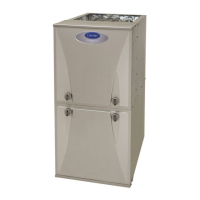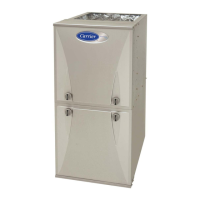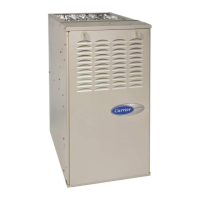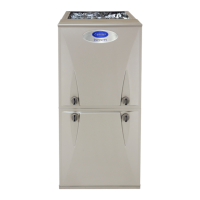PG92MSA: Installation, Start-up, Operating and Service and Maintenance Instructions
Manufacturer reserves the right to change, at any time, specifications and designs without notice and without obligations.
38
A13078A
Fig. 49 – Alberta and Saskatchewan Vent Termination
A93034
Fig. 50 – Combustion Air and Vent Pipe Diameter Transition
Location and Elbow Configuration
Recommended Combustion Air Inlet Moisture Trap
Recommended to prevent moisture from trickling into the furnace
vestibule, a trap can be installed in the intake air pipe near the furnace.
To prevent moisture, connecting a drain line to the trap is recommended
as trace amounts of moisture will evaporate into the intake air stream. If
the combustion air inlet is located near a moisture exhaust duct, or there
are other concerns of excessive moisture being drawn into the
combustion air inlet, it is encouraged to connect a drain line to the trap.
The trap can be constructed from a running tee of the same diameter of
the intake air pipe with EITHER a removable cap attached to a 6-inch
long pipe connected to the tee or the External Vent Trap Kit to help
prevent contaminants from entering the furnace. See Fig. 51.
The External Vent Trap Kit accessory may be used as a trap for the
combustion air inlet pipe if a large amount of moisture must be removed.
The drain line may be connected to the same drain as the furnace
condensate and the evaporator coil condensate line ONLY if the inlet air
trap drain and the evaporator coil drain empty into an open segment of
pipe above the drain. See Fig. 12. When using the External Vent Trap
Kit, refer to those instructions for proper drain connections.
The tee may also be connected to the intake air pipe on the side of the
casing. See Fig. 51.
In any configuration, it will be necessary to add the equivalent length of
the tee (15 feet/5 M) to the Total Equivalent Vent Length of the venting
system.
The measured length of pipe used in a single or 2-pipe termination is
included in the total vent length. Include deductions from the Maximum
Equivalent Vent Length (MEVL) contained in the Venting Tables for
elbows and flexible vent pipe. Factory accessory concentric vent
terminations or pipe lengths and elbows used for “standard” vent
terminations do not require a deduction from the Maximum Equivalent
Vent Length. See vent termination figures associated with Table 14.
Include a deduction for a Tee when used for Alberta and Saskatchewan
terminations.
NOTE: Polypropylene venting systems MAY require additional
deductions from the MEVL, or additions to the TEVL, for vent
terminations and flexible pipe sections. See the polypropylene venting
system manufacturer’s instructions for details on equivalent lengths of
vent terminations and flexible vent pipes, and for calculating total vent
lengths.
To calculate the Total Equivalent Vent Length (TEVL) of the venting
system:
1. Measure the individual distance from the furnace to the termination
for each pipe.
2. Count the number of elbows for each pipe.
NOTICE
!
OPTIONAL CONFIGURATION FOR COMBUSTION
AIR INLET PIPE
In applications where there is a risk of excessive moisture entering the
combustion air inlet pipe, a moisture trap may be added to the inlet pipe
to help prevent moisture from entering the furnace from the combustion
air inlet pipe. See Fig. 51.
When sizing venting systems, the equivalent length of the optional
moisture trap (15 feet/5 M) must be taken into account.
FURNACE
PIPE DIAMETER
TRANSITION IN
VERTICAL SECTION
NOT IN
HORIZONTAL
SECTION
NOTICE
!
ADDITIONAL INFORMATION FOR POLYPROPYLENE
VENTING SYSTEMS
Polypropylene venting systems include flexible vent pipe. These
flexible vent pipes have a different equivalent vent length than straight
sections of PVC/ABS DWV vent pipe. Be sure to make the appropriate
deductions from the Maximum Equivalent Vent Length (MEVL), or
additions to the Total Equivalent Vent Length (TEVL), when applying
flexible vent pipes in polypropylene venting systems. See the
polypropylene vent system manufacturer’s installation instructions for
details.
When using metric-sized venting systems, use these equivalencies for
obtaining the proper MEVL from the Tables:
Use 2” Vent Tables for 60 mm (o.d.) vent systems
Use 3” Vent Tables for 80 mm (o.d.) vent systems
Use 4” Vent Tables for 100 mm (o.d.) vent systems

